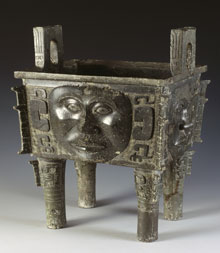
EXQUISITE DETAIL Bronze Age creations from China at Bowdoin include “Rectangular Ding with Human-face Design.” |
Chinese bronzes are often felt, quite rightly, to fall within the purview of scholars and collectors who delight in detailed changes from one period or region to another. But the deeply interesting "Along the Yangzi River: Regional Culture of the Bronze Age from Hunan," nestled quietly on the upper floors of the Bowdoin College Museum of Art, gives the ordinary viewer a chance to enter their world and get glimpses of the time and age they study, and to enjoy and puzzle over these remarkable works.The Bronze Age began around 3000 years BCE, when people first learned to smelt ore and to make the copper-tin alloy that gives bronze its higher strength than the much softer and easily-worked copper. Copper was common and tin more rare, but the metallurgical technology spread across a great swath of the world fairly quickly. As did, one suspects, the tin trade — not much tin is needed to make bronze.
Most of the artifacts in this show were gathered from archeological sources by the Hunan Provincial Museum, which loaned them to the China Institute in New York for an exhibition earlier this year. Bowdoin is the only other venue for the show. Its purpose is to present the indigenous methods and styles of the area in the Yangzi River plain in Hunan Province as distinct from, although influenced by, the better-known bronzes from the Shang and Zhou dynasties to the north and west. The pieces have important archeological and historical significance, because the documentary history of the area is incomplete. These finds teach the experts about the historical flow of ideas.
I don't have the background to follow the historical issues in question, so much of what I see in these pieces is subjective, but still real, at least to me. The makers of these objects were artisans of high skill and knowledge, and the pieces were clearly very expensive to make. Most were probably used in rituals by a political and economic elite.
The tone of the show was set, for me, by the four-sided "Rectangular Ding with Human-face Design" from the 12th to 11th century BCE. One of the faces seemed more animated than the others, a feeling I once had looking at a number of nearly identical inscribed Egyptian bricks from the Akhenaten period. It made the lives of the anonymous artists (in both cases, probably slaves) tangible to me — someone a long time ago was deeply engaged in what they were doing.
Bronze casting three thousand years ago was laborious and dangerous. The furnace would have been charcoal-fired with air forced into a pit to produce sufficient heat to melt the metal. Pumping the bellows would have been tedious and tiring. The molds would have been ceramic, fired in a kiln and broken off after the cast had cooled. No steel tools were available to hold the crucible or chase the casting, and they had very little protection against the 2000 degrees needed to melt bronze. There were likely few rewards for success and perhaps much to fear from failure (see the Yue [Battle Axe] with Tiger Motif).